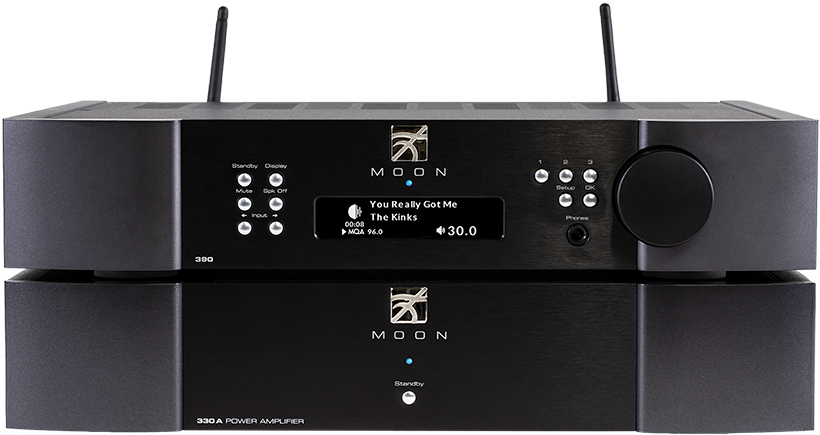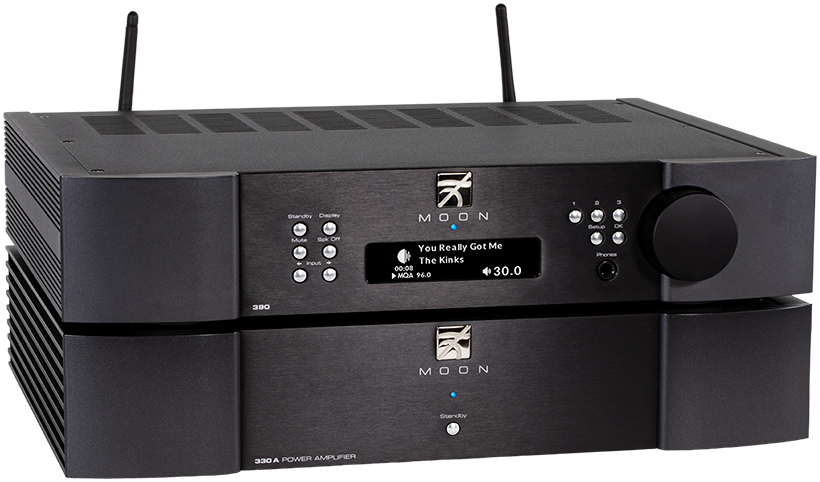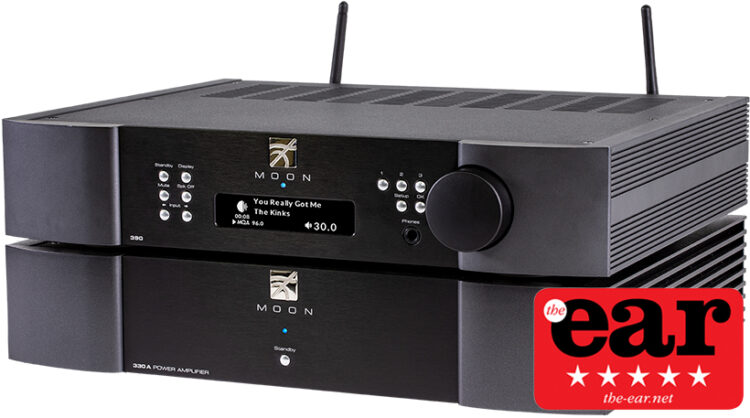It is a long time since I had a separate pre and power amplifier in my system, the last being the highly accomplished Naim NAC 552 pre and NAP 300 power amps. They had to be sold when redundancy struck in 2008 and we needed to turn some of our less essential assets into cash. Since 2014 amplifier duties on my rack have been undertaken by the Yamaha A S3000 integrated, and a very fine job it does too. I have reviewed other units in the intervening time but have always been very happy to manhandle the Yamaha back on to its allocated shelf on the rack. And then our esteemed editor asked if I would review the Moon 390 and of course I was happy to accept the challenge. I suggested to the nice folk at Renaissance Audio that a power amplifier might be handy too, so they dispatched both units to Kelly towers. They arrived the day before I set out for the Bristol Show, so I installed the week after that event. They have been working for just over three weeks in my system now, so we have had time to get used to each other.
You can read the full specification for both at the end of this review, but here are the highlights. The 390 is a very fully featured preamplifier, with a built in phono stage, supporting both MM and MC cartridges, and is configurable. More of that in due course. There are single ended and balanced analogue inputs alongside outputs on the same connections with the RCA option in variable and fixed varieties. The digital side is very richly endowed. Inputs include optical, coax, AES-EBU, HDMI inputs and HDMI out with ARC capability, and USB Type B for connecting a computer or music server. There is a USB host slot for a powered hard drive or similar. There are two WiFi antennae and a pair of ethernet sockets, so that the 390 can act as a switch. There is also Bluetooth connectivity for pairing with suitable devices. That is quite a list!

Control is either by the supplied remote control (a rather lightweight device which works fine but seems at odds with the quality feel of the unit) or by using the Simaudio app, called MIND. This seems to be very well sorted and during the review period I experienced no glitches whatsoever. I would need a lot longer than the few weeks to explore all the capabilities of this system, so I am not going to address the HDMI side at all. Our TV is connected via the Toslink input and that works just fine.
On to the 330A power amplifier. It’s rated output into 8 ohms is 125 watts per channel, and 250 into 4 ohms. This is a sleek looking but hefty device with a shipping weight of 15kg, sporting just an on/off button and blue LED on the fascia. The back panel is very straightforward. An IEC socket with an on/off rocker switch, two pairs of speaker outlets and the choice of XLR or RCA inputs from a preamplifier. I initially used AudioQuest Earth XLR cables to connect the 390 with the 330A. My usual Harbeth Super HL5+ 40th Anniversary loudspeakers were connected using Tellurium Q’s excellent Ultra Black II cable. Should you need it, the 330A can be bridged to mono for an impressive 400 watts into 8 ohms. There is also a spare fuse included with the instruction book, which is a nice touch. Thankfully it has not been needed so far on this visit to Devon.
Once the two units were installed on my Quadraspire XL rack I plugged my Trilogy 907 phono-stage in to the single ended inputs on the 390 and my Yamaha CD S3000 into the balanced inputs. The RCA cable is AudioQuest Wind, and the XLRs are Tellurium Q Black. The Trilogy signal comes from a Linn Sondek LP 12, rebuilt using a mixture of Linn and Tangerine Audio hardware. The Arm is a Linn Ittok and the cartridge is a Lyra Kleos. Power comes into all the units in my system from an Audioquest Niagara 1000 and I used Audioquest NRG Y3 mains cables on all components. The units were stone cold when I started to listen, so I just played a selection of CDs and SACDs for the first two days, with the occasional record to keep that side warm. But even cold, I realised that something pretty special was happening.

After two days I sat down in my listening chair and started to listen more critically. First impressions always count, and these were overwhelmingly positive. Whether playing silver discs or vinyl, I was totally immersed in the music. The grip on the Harbeths was extraordinary. Subtle detail was revealed clearly yet there was tremendous bass slam when required. I played disc after disc and loved the clean, powerful sound of the Moon pairing. Effortless, yet with rhythm, pace and timing very reminiscent of my high end Naim system more than a decade ago, but with a slightly more three dimensional presentation. It boogies hard when required but has a brilliant lightness of touch with acoustic and classical material too. Stereo imaging and sound staging are absolutely terrific. Individual instruments have their own space and do not wander about disconcertingly.
In the second week I made a couple of changes. I removed the Trilogy 907 and plugged the LP12 directly into the 390. I was able to configure the MC stage to suit the Lyra Kleos. I cued upDark Side of the Moonside two, and sat down to listen to ‘Money’. Good Grief, this was seriously good! I had replaced a great sounding phono-stage which retails for somewhere just under £3,000 with the built in one and it sounded almost the same. Record followed record and I was totally hooked. Could I live with this? Absolutely yes. In a heartbeat, like the one on Dark Side!
I also got the Network input working. My usual streamer is a Naim NDX, which is a fine device, but that was retired for this review. Hardwired with Ethernet cable to my gigabit switch, the 390 has been a delight to use through the MIND app. As I write this I am listening to John Mayall’s latest album Nobody Told Meon Qobuz, streaming at 48kHz from a FLAC file. I also have played the vinyl today. The streamed sound is genuinely excellent.
The other change I have made is with the XLR interconnect between the 390 and the 330A. There will be a separate review for this but suffice it to say that XLR cable differences were very audible. It is worth trying different ones to find the best sound for you.

Another thing I like about the Moon 390 is that when you change the volume setting the scale on the display is magnified for easy reading across the room, then shrinks back down to a much smaller size, the same happens when changing inputs. That sort of thoughtful design choice is very welcome and got warm praise from Mrs Kelly. Our usual integrated amplifier has no visual clues as to where the volume level is set at any given time and is a continuing source of minor irritation. Moon’s approach is elegant and very user-friendly. The display can also be switched off if the user prefers, and only illuminates when a setting is changed.
TV sound through the Toslink interface is exceptional. Both of us have commented on the added clarity to dialogue, and action scenes and movie soundtracks are conveyed with loads of weight. Are there any criticisms? Honestly, almost none. I think the remote control feels flimsy and cheap, which is totally at odds with the design and build quality of the units themselves, which is exemplary. However, it does the job.
So how does one summarize all this? I think the Moon 390 and 330A represent the best fully featured amplification system I have heard at under £10,000, and calls into question why one would ever need to spend more. I have totally fallen in love with the sound, the functionality, the look and the quality of these Canadian beasts. Playing music has never been more pleasurable than it has been these past few weeks – I would happily spend the rest of my life with these Moon pieces at the heart of my system. Make no mistake, they are irresistible. Only audition if you are ready to handover the money to your friendly Moon retailer!


